![]()
![]()
![]()
Use LEFT and RIGHT arrow keys to navigate between flashcards;
Use UP and DOWN arrow keys to flip the card;
H to show hint;
A reads text to speech;
57 Cards in this Set
- Front
- Back
- 3rd side (hint)
|
Cells |
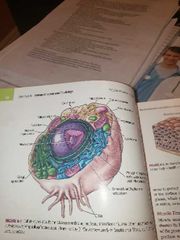
Cells are the smallest living units in the body,For cells the raw materials includes oxygen from the air and food molecules such as sugars and amino acids, The product are often more complex molecules. such as hormones or protein. |
|
|
|
Muscle cell |
Muscle cell use up large amount of sugar and oxygen to power their own movement, and neurons (nerve cell). Use the same raw material to create electrical and chemical signals. |
|
|
|
Nucleus |
The nucleus contains DNA , DNA is arranged in functional units called genes, and genes are linked together in long strings called chromosomes, genes performed two functions. During the normal life of the cell, the act as blue print for making proteins. During cell reproduction, the act as the material of heredity, forming copies of themselves so that each new cell formed has a complete and identical set of blueprints. |
|
|
|
Defects in genes are responsible for hereditary diseases such as? |
Hemophilia and sickle cell disease |
|
|
|
All cells in the body begins with a? |
Nucleus, but red blood cells push out their's at maturity. |
|
|
|
Cytoplasm |
Cytoplasm refers to all the cellular material except plasma membrane and the nucleus. Cytosol is the fluid portion of the cytoplasm. |
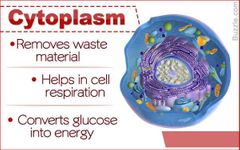
|
|
|
Plasma membrane |
The plasma member encloses the cells and tightly regulate the flow of materials in and out of it. Membranes are flexible, allowing cells to change shape if necessary. for instance, the red blood cell must squeeze through tiny capillaries that are thinner that it's normal diameter, a feat made possible by the flexibility of the membrane. |
|
|
|
The human body is composed of the following 4 basic type of tissue? |
Epithelial Tissue, muscle tissue, nerve tissue, connective tissue. |
|
|
|
Epithelial tissue |
Epithelial tissue forms flat sheets and is most often found on surfaces where exchanged with the environment takes place, such as the lining of the gut or where rapid regeneration must occur to protect internal structures, Such as the skin or the surface of the eye. |

|
|
|
Epithelium |
May contains glands, which produce and secrete substances such as saliva, sweat or insulin. |
|
|
|
Muscle tissue |
Muscle tissue is contractile, meaning it can shorten its length. Muscle cell contain long fibers of the proteins actin and myosin. Who's movements produce muscle contraction. muscle receive the stimulus a contract when the axon terminals of motor neurons |
|
|
|
The neurons releases a chemical called? |
A neurotransmitter |
|
|
|
Skeletal muscle or striated voluntary muscle |
Is the most Widespread type, constituting all the muscle that move the skeleton. Under the microscope, striated muscle had a striped appearance. |
|
|
|
Cardiac muscle, or striated involnuntary muscle |
Is found in the heart. It looks similar to skeletal muscle but have features that are unique to it. Cardiac muscle cells do not need stimulation by the nervous system to start a contraction. However, electrical stimulation is required to maintain the coordinate rhythm of the cells. This function is performed by the hearts physiologic pacemaker, found in the right atrium. |
|
|
|
Smooth muscle, nonstriated involuntary muscle |
Lines blood and lymph vessels within the body just bellow the epithelial tissue, such as around the gut, lungs, bladder, and circulatory and reproductive systems. Smooth muscle contraction of the passage of materials through the vessel. For instance, contraction of intestinal smooth muscle propels food along the digestive system. contraction of smooth muscles surrounding veins constricts the vessel, the decreased flow through the vein. smooth muscle also is found in the skin, come one where it is responsible for hair erection. |
|
|
|
Nerve tissue |
Nerve tissue is specialized for intercellular communication by the conduction of electrical impulses and release of chemical messages. Nerve tissue is compose of neurons and neurological cells. |
|
|
|
Nerouns are found? |
In the brain and spinal cord and throughout the body. |
|
|
|
Neuroglial cells |
Nourish and support neurons in the brain and spinal cord. |
|
|
|
The are 3 major portions of the neuron are? |
Dentrite Cell body Axon |
|
|
|
Axons are insulated by a fatty sheath of? |
Myelin |
|
|
|
One neuron conveys information to another by realizing a chemical call a? |
Neutronsmitter |
|
|
|
Connective tissue |
The general function of connective tissue is the bind and support the other 3 types of tissue. connective tissue is characterized by a relative scarcity of cells and the relative abundance of extracellular ground substance secreted by the cells. Connective tissue is ground substance is collagen, impregnated with mineral crystals. Blood is also a connective tissue, with plasma as its ground substance. |
|
|
|
Muscle tissue occurs in 3 forms |
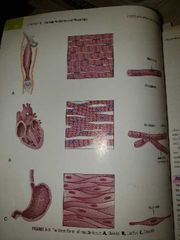
|
|
|
|
Ventral and Anterior refers to? |
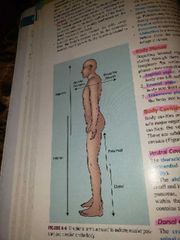
The front surface of the body. Venipuncture is perform on the ventral surface of the fore arm. |
|
|
|
Dorsal and posterior |
Refers to the back surface of the body. Hand venipuncture is usually perform on the dorsal surface of the hand. |
|
|
|
Lateral |
Means more towards the side away from the body's central axis. |
|
|
|
Medial |
Means more toward the middle. |
|
|
|
Distal means? |
Farther from the point of origin of the structure in question. The elbow is distal to the shoulder. |
|
|
|
Proximal means? |
Closer to the point of attachment. |
|
|
|
Inferior means? |
Bellow, the mouth is inferior to the nose. |
|
|
|
Superior means |
Above. The eyebrow are superior to the eyes. |
|
|
|
Prone means? |
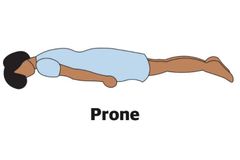
Lying on the abdomen with the face down. |
|
|
|
Supine means? |
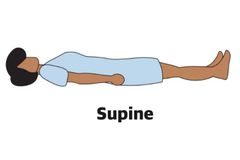
Lying on the back with face up. Patient may be in supine position during venipuncture if they are like to faint. |
|
|
|
Flexion refers to? |

A movement that bends a joint. |
|
|
|
Extension |
Straighten the joint. |
|
|
|
Abduction |
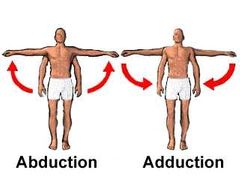
Is a movement that takes a body part farther from the central axis. |
|
|
|
Adduction |
Bring it closer. |
|
|
|
Body planes |
Depicting internal organs Is often best done slicing through them to make a section. |
|
|
|
Sagittal plane: |
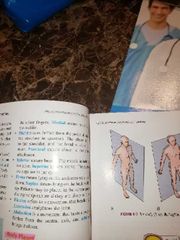
A vertical plane dividing the body into left and right |
|
|
|
Frontal plane: |
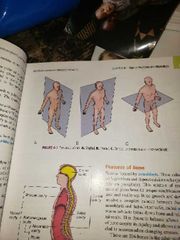
A vertical plane dividing the body into front and back. |
|
|
|
Transverse plane: |

A horizontal plane dividing the body into top and bottom |
|
|
|
Body cavities? |
Body cavities are spaces within the body that contains major organ system. there are 2 large body cavities: the ventral cavity and the dorsal cavity, these are subdivided into to form the 8 major body cavities. |

|
|
|
Ventral cavities subdivision The ( Thoraic cavity) |
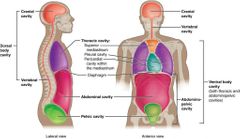
Contains the heart. ( within the pericardial cavity) and lungs (within the pleural cavity. |
|
|
|
The abdominal cavity |
Contains the stomach, small and large intestine, spleen, liver, gallbladder, pancreas, and kidney ( all kidneys are within the peritoneal cavity) the PELVIC CAVITY contains the bladder, rectum, ovaries and testes. |
|
|
|
Dorsal cavity subdivision |
The CRANIAL CAVITY contains the brain, and the spinal cavity and the spinal cord. |
|
|
|
The body act to maintain? |
Hemostasis, or the dynamic steady state we think of when refer to good health. |
|
|
|
Witch test detected early pregnancy? |
(hCG) human chorionic gonadotropin tests. |
|
|
|
Bone is formed by? |
Osteoblasts. |
|
|
|
The two bones are held together with? |
Ligaments. |
|
|
|
Muscle attach to the skeleton by means? |
Tendons |
|
|
|
The integumentary system? |
Forms the outer covering of the body and includes the skin, hair, nails, and sweat glands. |
|
|
|
Is responsible for the absorption of nutrients into and the elimination of waste from the digestive tract? |
Digestive System |
|
|
|
Smooth muscle of the esophagus constrict in wave like motion called? |
Peristalsis |
|
|
|
The entire structure, from glomerulus to collecting duct, is known as? |
Nephron. |
|
|
|
Comprises the glands and other tissues that produce hormones.? |
Endocrine system |
|
|
|
It is often called the master gland of the endocrine system? |
Pituitary Gland |
|
|
|
The testes produce testosterone? |
Gonads |
|

